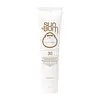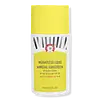What's inside
What's inside
 Key Ingredients
Key Ingredients

 Benefits
Benefits

 Concerns
Concerns

 Ingredients Side-by-side
Ingredients Side-by-side

Titanium Dioxide 5.3%
Cosmetic ColorantZinc Oxide 2.4%
Cosmetic ColorantCyclopentasiloxane
EmollientIsopropyl Myristate
EmollientPolyamide-5
Skin ConditioningDimethicone Crosspolymer
Emulsion StabilisingStearalkonium Hectorite
Gel FormingPolysilicone-11
Oryza Sativa Bran Extract
Skin ConditioningRosmarinus Officinalis Leaf Extract
AntimicrobialHelianthus Annuus Extract
EmollientTocopherol
AntioxidantPropylene Carbonate
SolventHydrogen Dimethicone
Aluminum Hydroxide
EmollientSilica Silylate
EmollientTitanium Dioxide 5.3%, Zinc Oxide 2.4%, Cyclopentasiloxane, Isopropyl Myristate, Polyamide-5, Dimethicone Crosspolymer, Stearalkonium Hectorite, Polysilicone-11, Oryza Sativa Bran Extract, Rosmarinus Officinalis Leaf Extract, Helianthus Annuus Extract, Tocopherol, Propylene Carbonate, Hydrogen Dimethicone, Aluminum Hydroxide, Silica Silylate
Zinc Oxide 22%
Cosmetic ColorantEthylhexyl Olivate
Skin ConditioningIsododecane
EmollientCoconut Alkanes
EmollientWater
Skin ConditioningAluminum Starch Octenylsuccinate
AbsorbentCaprylic/Capric Triglyceride
MaskingButylene Glycol
HumectantMica
Cosmetic ColorantPolyglyceryl-6 Polyricinoleate
EmulsifyingJojoba Esters
EmollientCellulose
AbsorbentStearalkonium Hectorite
Gel FormingSodium Chloride
MaskingSqualane
EmollientPolyglyceryl-3 Diisostearate
EmulsifyingPolyglyceryl-3 Polyricinoleate
EmulsifyingIron Oxides
Phenoxyethanol
PreservativeTocopheryl Acetate
AntioxidantCoco-Caprylate/Caprate
EmollientTrihydroxystearin
Skin ConditioningCaprylyl Glycol
EmollientPolyhydroxystearic Acid
EmulsifyingGlycerin
HumectantTrisodium Ethylenediamine Disuccinate
Propanediol
SolventSorbic Acid
PreservativeTitanium Dioxide
Cosmetic ColorantSilica
AbrasiveGlycyrrhiza Glabra Root Extract
BleachingCamellia Sinensis Leaf Extract
AntimicrobialAlumina
AbrasiveTocopherol
AntioxidantChrysanthemum Parthenium Extract
Skin ConditioningZinc Oxide 22%, Ethylhexyl Olivate, Isododecane, Coconut Alkanes, Water, Aluminum Starch Octenylsuccinate, Caprylic/Capric Triglyceride, Butylene Glycol, Mica, Polyglyceryl-6 Polyricinoleate, Jojoba Esters, Cellulose, Stearalkonium Hectorite, Sodium Chloride, Squalane, Polyglyceryl-3 Diisostearate, Polyglyceryl-3 Polyricinoleate, Iron Oxides, Phenoxyethanol, Tocopheryl Acetate, Coco-Caprylate/Caprate, Trihydroxystearin, Caprylyl Glycol, Polyhydroxystearic Acid, Glycerin, Trisodium Ethylenediamine Disuccinate, Propanediol, Sorbic Acid, Titanium Dioxide, Silica, Glycyrrhiza Glabra Root Extract, Camellia Sinensis Leaf Extract, Alumina, Tocopherol, Chrysanthemum Parthenium Extract
 Reviews
Reviews

Ingredients Explained
These ingredients are found in both products.
Ingredients higher up in an ingredient list are typically present in a larger amount.
Stearalkonium Hectorite is a clay-derived ingredient used to thicken a product and help create a gel-like texture.
Titanium dioxide is a mineral UV filter widely used in sunscreens and cosmetics.
It is one of only two UV filters officially classified as “mineral” by regulatory agencies, the other being zinc oxide.
Titanium dioxide provides broad-spectrum protection mostly in the UVB and UVAII range, with some protection in the UVAI range.
While its UVA protection isn’t as strong as zinc oxide’s, the difference is minor.
A common myth is that mineral UV filters reflect UV light. However, modern research shows titanium dioxide absorbs UV radiation like chemical filters (~95% absorption & 5% reflection).
Thanks to its non-irritating nature, titanium dioxide is suitable for sensitive, acne-prone, or redness-prone skin. It is unlikely to cause "eye sting" like other sunscreen ingredients.
A major drawback of this ingredient is its white cast and thick texture. This is why mineral sunscreens often leave a white cast and are less cosmetically elegant than chemical/hybrid sunscreens.
To improve white cast and spreadability, micronized or nano-sized titanium dioxide is often used.
There are ongoing concerns surrounding nano-titanium oxide's impact on marine ecosystems.
There is no conclusive evidence that any form of titanium oxide (or any other sunscreen ingredients) will cause harm to marine ecosystems or coral reefs. The science is still developing but many consumers are keeping a close eye on this issue.
Please note, many destinations have reef-safety sunscreen rules. For instance, the U.S. Virgin Islands advises all visitors to use non-nano mineral sunscreens.
Nano mineral sunscreens once raised safety concerns about absorption into skin.
Extensive research has shown that they do not penetrate healthy or damaged skin; they remain safely on the surface and the top layer of dead skin (stratum corneum).
You'll likely find titanium dioxide bundled with alumina, silica, or dimethicone. These ingredients help make titanium dioxide highly photostable; this prevents it from interacting with other formula components under UV light.
Learn more about Titanium DioxideTocopherol (also known as Vitamin E) is a common antioxidant used to help protect the skin from free-radicals and strengthen the skin barrier. It's also fat soluble - this means our skin is great at absorbing it.
Vitamin E also helps keep your natural skin lipids healthy. Your lipid skin barrier naturally consists of lipids, ceramides, and fatty acids. Vitamin E offers extra protection for your skin’s lipid barrier, keeping your skin healthy and nourished.
Another benefit is a bit of UV protection. Vitamin E helps reduce the damage caused by UVB rays. (It should not replace your sunscreen). Combining it with Vitamin C can decrease sunburned cells and hyperpigmentation after UV exposure.
You might have noticed Vitamin E + C often paired together. This is because it is great at stabilizing Vitamin C. Using the two together helps increase the effectiveness of both ingredients.
There are often claims that Vitamin E can reduce/prevent scarring, but these claims haven't been confirmed by scientific research.
Learn more about TocopherolZinc Oxide is a mineral broad-spectrum UV filter; it is the broadest UVA and UVB reflector approved by the FDA. It also has skin protectant and skin soothing properties.
Zinc oxide is one of the most effective broad-spectrum UV filters. It protects against UVB, UVAII, and UVAI. In comparison to its counterpart titanium dioxide, zinc oxide provides uniform and extended UVA protection.
Another great benefit? This ingredient is highly photostable so it won't degrade easily under sunlight.
A common myth is that mineral UV filters are widely believed to primarily reflect UV light.
However, modern research shows titanium dioxide absorbs UV radiation like chemical filters (~95% absorption & 5% reflection).
Zinc oxide has great skin soothing properties so you'll likely find this in sunscreens formulated for sensitive skin or babies/children. It is unlikely to cause "eye sting" like other sunscreen ingredients.
Regulatory agencies consider zinc oxide to be non-toxic and safe. It has also been shown to not penetrate the skin.
Unfortunately, this ingredient does leave a visible white cast. This is why mineral sunscreens are often less cosmetically elegant than chemical or hybrid ones.
In cosmetics, zinc oxide can be found in both non-nano and nano-sized forms. The nano version is used to reduce white cast and improve the texture of sunscreen formulas.
There are ongoing concerns surrounding nano-zinc oxide's impact on marine ecosystems and whether it can be absorbed into skin.
Regarding marine ecosystems and coral reefs, there is no conclusive evidence that any form of zinc oxide (or any other sunscreen ingredients) will cause harm. The science is still developing but many consumers are keeping a close eye on this issue.
Please note, many destinations have reef-safety sunscreen rules. For instance, the U.S. Virgin Islands advises all visitors to use non-nano mineral sunscreens.
There has also been some stir about whether micronized or nano zinc oxide has potential photoxicity and absorption through the skin/lungs.
An in-vitro (done in a test tube or petri dish) study demonstrated micronized zinc oxide to have potential phototoxicity. There's no need to fret; the EU Commission's Scientific Committee on Consumer Safety has stated, "The relevance of these findings needs to be clarified by appropriate investigations in vivo." Or in other words, further studies done on living organisms are needed to prove this.
Current research shows zinc oxide nanoparticles do not penetrate intact or sunburned skin. They either remain on the surface or in the outermost layer of dead skin (stratum corneum).
Zinc oxide is one of only two classified mineral UV filters with titanium dioxide being the other one.
Fun fact: Zinc has been used throughout history as an ingredient in paint and medicine. An Indian text from 500BC is believed to list zinc oxide as a salve for open wound. The Ancient Greek physician Dioscorides has also mentioned the use of zinc as an ointment in 1AD.
Learn more about Zinc Oxide